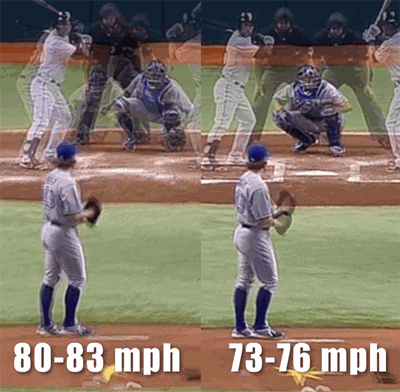Tracking R.A. Dickey’s Knuckleball
You all know the R.A. Dickey story by now. Journeyman major leaguer reinvents himself as a knuckleball thrower in his 30s, then refines the pitch to become one of the better starting pitchers in baseball, culminating with his selection as the National League Cy Young Award winner last year. The knuckleball is always a fascinating pitch, and Dickey is a fascinating guy, so there has been no shortage of media attention focused his direction.
While I was not working here at FanGraphs last year, I could not resist taking a belated look at some of Dickey’s dominating knuckleballs from that 2012 season. I’ve selected three particularly impressive pitches from that campaign and used an effect known as StroMotion to help track their movement.
While traditional pitches create movement through spin induced by grip and arm action (exceptional curveballs have been measured at 2,500-3,000 revolutions per minute) creating high pressure zones that deflect the ball in the opposite direction, the key to the unique movement of the knuckleball is a near complete lack of spin. The ideal knuckleball makes just 1 to 1.5 rotations (~150 RPM) between release and home plate, causing the drag on the ball to shift significantly mid-flight as the leading seam of the ball rotates slightly, resulting in unpredictable and uniquely sudden movement.
While the pitches shown above are an extreme, an average knuckleball still varies its trajectory from pitch to pitch enough to throw off hitters effectively. Below, I put together a composite of a more typical variety of knuckleballs for comparison.
You can see why opposing hitters had some problems. If there’s no way to predict where the ball is going to go, hitting it is quite difficult indeed.
However, with a trade to the American League in 2013, Dickey has not yet been able to repeat his success that he achieved in New York. His walk rate in particular has risen from 2.08 per 9 innings to 3.65 BB/9, well above any mark he posted during his time in New York. Along with a drop in his strikeout rate, Dickey simply hasn’t been the dominant front-line starter that Toronto was hoping for when they acquired him.
While the inherently inconsistent movement of the knuckleball makes the small sample size movement comparisons I’ve done on other pitchers impossible to take conclusions from, FanGraph’s own Eno Sarris looked at one possible explanation for his struggles earlier this season: the drop-off in use of Dickey’s “power” knuckleball, which he throws in the 78-83 mph range.
This image from that piece really demonstrates how many fewer hard knuckleballs Dickey has been throwing this year.
While a slower knuckleball should allow for more movement, the varied speed and possibly improved control of the increased velocity likely contributed significantly to Dickey’s 2013 season. Last week, Eno published an interview with Dickey, where he noted that health issues were bothering him but he felt he was able to take the mound and compete even if he was at less than full strength.
Sarris: Why don’t you just take 15?
Dickey: Because I can still muster through six or seven innings. Even though I haven’t had my best knuckleball, I still have seven or eight quality starts. So I can still give something. Just a matter of not being as dominant as I was because I’m missing a weapon or two. It’s feeling better, though, this last week.
While most changes of speed in baseball are done through grip, Dickey’s varied knuckleball speeds are induced through arm speed. When he talks about “missing a weapon”, it appears that this might be what he’s referring to. I’ve compared his pitching motions this season on several pitches in each speed range to illustrate how Dickey’s adds velocity.
It might be difficult to see, but there is in fact a difference in arm speed and a slightly more violent motion to the hard knuckler, and given his back and neck issues, it appears that he’s less willing to inflict that motion on his body this season. Thus, the switch to more of a traditional slower knuckleball, and while correlation is not causation, it seems likely that this change is contributing to his lessened performance in 2013.
While he may never repeat his Cy Young season, the Blue Jays probably haven’t yet seen a full strength version of R.A. Dickey yet. If he gets back to being able to throw his harder knuckleball in the second half of the year, he might yet give them a glimpse of the pitcher the Mets saw last year.
Drew Sheppard is a writer for FanGraphs, graphic artist and GIF enthusiast. If you have a topic you would like Drew to take a look at in the future using overlay GIFs, please let him know in the comments here or on Twitter @DShep25.





Maybe he’s not “reaching” quite so well because of the back.
Great gifs.